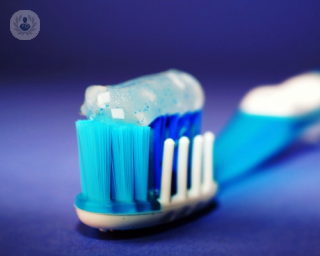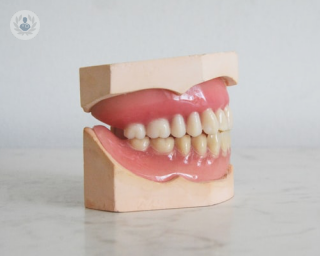Gingivitis
Dr Federico Tinti - Dentistry
Created on: 10-28-2015
Updated on: 06-02-2023
Edited by: Jay Staniland
What is gingivitis?
Gingivitis is a periodontal disease, which affects the tissues that support the teeth such as the gingiva (the part of the gums around the base of the teeth), periodontal ligaments and the alveolar bone. The most common form of gingivitis is also the most common type of periodontal disease, caused by plaque on the teeth.

What are the symptoms of gingivitis?
The symptoms of gingivitis are the following:
- Gums being inflamed and red or purple, instead of their usual pink colour.
- The gums bleeding during or after being brushed.
- The gums hurt when touched, though they are not painful otherwise.
- The appearance of sores.
- A bad breath and a bad taste.
- The gums are shrinking.
Gingivitis can be improved if it is detected and treated early. Visit a dentist if you have any symptoms, especially inflammation and bleeding.
How does gingivitis occur?
Gingivitis is caused by the build-up of plaque on the teeth. Plaque build-up is composed of food residues, mucus and bacteria that accumulates on the teeth and, if not properly cleaned, can become tartar. Tartar takes a hard consistency and is trapped at the base of the teeth, collecting bacteria. The bacteria that make up the plaque then cause inflammation of the gums through proximity. The amount of inflammation will increase the longer the plaque and tartar remain on the teeth, irritating the gingiva. Over time, the gums will become swollen and will bleed easily.
Gingivitis that doesn't receive quick and appropriate treatment once bleeding and inflammation occur, can become periodontitis, a serious condition that affects underlying tissue and bone. Periodontitis can damage the jaw bone, causing small spaces to open up between the gums and the teeth. The teeth can become loose, leading to tooth loss. Other parts of the body can also be affected, such as the lymph nodes, the eyes and even the heart, increasing the risk of a stroke or a heart attack.
Necrotising ulcerative gingivitis, also called trench mouth, is another complication of gingivitis that can cause infected, painful, bleeding gums and ulcerations.
Anyone can develop gingivitis at any stage of their life. There are several factors that can increase the risk of gingivitis, such as:
- poor dental care habits
- smoking
- age
- dry mouth
- uncontrolled diabetes
- poor nutrition
- badly fitted dental restorations
- teeth that are difficult to clean, for example, due to their shape
- immune system disorders
- certain medication
- hormonal changes
- family history of gingivitis
- certain infections.
How is gingivitis diagnosed?
Gingivitis is diagnosed through:
- A review of a patient's dental history.
- An examination of the gums, teeth, mouth and tongue.
- A measurement of the pocket depth of the indentation between the gums and the teeth.
- X-rays of the teeth and jaw bone.
- A medical evaluation.
Can gingivitis be prevented?
Gingivitis can be prevented by good dental hygiene, such as brushing your teeth three times a day with an electric or an interdental toothbrush and flossing – follow your dentist’s recommendations for the best dental hygiene routine. The use of dental floss is very important to remove plaque and food residues that remain between the teeth, and floss should be used especially before bedtime. Consider using a mouth rinse as well as to help remove left over tartar and plaque even more.
A regular dental cleaning at the dentist’s office is also recommended, which thoroughly removes all tartar.
What is the treatment for gingivitis?
The main objective in the treatment of gingivitis is to reduce the inflammation.
To remove the build-up of tartar, plaque and bacteria, the dentist will perform a professional dental cleaning procedure consisting of two parts: scaling (for the tartar and bacteria) and root planning (for smooth root surface and proper healing) using laser, instruments or an ultrasonic device.
Depending on the severity of the gum disease, you may need to: take antibiotics; have teeth removed or have surgery for the gums.
After this, you may be recommended dental restoration if you have misaligned teeth, bridges or crowns not fitted properly that are contributing to the gingivitis.
You will then have to follow good hygiene practice, making sure to brush and floss, to support the cleaning process of gingivitis. The dentist will also be able to recommend suitable mouthwashes or other types of dental cleaning products which can help with the condition.
Gingivitis is the earliest stage of gum disease and thus, will not cause permanent damage to the teeth or mouth unless it is left untreated or is very severe. Pink, healthy gums will return within days or weeks if - after the professional cleaning - you have a good oral hygiene and you are consistent with it.
Is gingivitis contagious?
Gingivitis-causing bacteria can spread from one person to another through saliva, by sharing toothbrushes or eating utensils, kissing, or drinking from the same glass.
However, while saliva can spread the bacteria that contributes to gingivitis to your mouth, gingivitis and gum disease are not contagious. It is not guaranteed that you will develop gingivitis after exposure to the bacteria. Only people with poor oral hygiene will be at an increased risk of gingivitis after the transmission of bacteria.
Avoid sharing straws, cups, glasses, toothbrushes or other tools that are in direct contact with your mouth if your partner or a family member with whom you live with has gingivitis. Bacteria can spread more quickly this way.
Gingivitis during pregnancy
Around 60 to 70 per cent of pregnant women get sore and swollen gums that may bleed, due to a build-up of plaque. This is caused by the rise of progesterone hormone levels during pregnancy, which promotes an inflammatory response that makes the gums more susceptible to the onset and accumulation of plaque. This condition is called pregnancy gingivitis.
Symptoms can occur anytime between the second and eighth month, usually turning more severe during the second trimester. Pregnancy gingivitis can also lead to periodontitis, which has been connected to pregnancy complications such as preterm birth and low-birth-weight babies.
While pregnancy gingivitis will generally resolve itself after delivery, it is important to keep good oral hygiene while pregnant to prevent, or treat, any type of gum problem that develops.
In particular, if a pregnant woman experiences morning sickness (symptoms of nausea and vomiting in the morning), it is best to rinse only with water. This way, the teeth will not be damaged by the acid in the vomit. Wait an hour before brushing the teeth as the teeth will be softened by the stomach acid.












